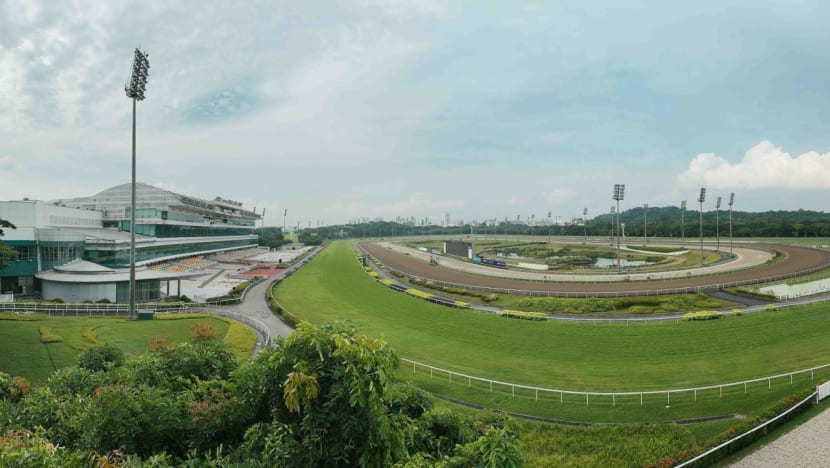Singapore Turf Club closure: Youths’ view of horse racing as 'old man's game' among factors cited for sport’s waning support

A photograph of Singapore Turf Club at Kranji taken on June 6, 2023.
SINGAPORE — For Mr Leonard Tan, 27, horse racing at the Singapore Turf Club is the only betting activity that he avoids, as he believes that the sport is the domain of the older generation.
“I’m used to a lot of information being available on the web and available digitally,” said Mr Tan, who prefers betting on games such as 4D, Toto, and those found in casinos.
Mr Tan, who worked until recently at Singapore Turf Club in Kranji in an administrative role for Singapore Pools, said people who place bets on horses tend to buy booklets, or race guides, with key information on the races beforehand.
This information is hard to find online — meaning that newcomers are not likely to be drawn to the sport as it is inaccessible, he said.
Despite the Sport of Kings boasting an illustrious 180-year history here, punters and professionals told TODAY that the horse-racing industry's declining popularity can be attributed to its complex nature and its image as an “old man’s game”.
Amid this slide in popularity, the Government announced on Monday that Singapore Turf Club will close down by March 2027 and the site will be redeveloped to “better meet” future land use needs, including for public housing.
About 350 employees are expected to be affected by the closure.
The move comes as average attendance per race day plummeted from around 11,000 in 2010 to 2,600 in 2022 — a trend seen not just in Singapore but also globally.
In the United States, more than 40 horse racing tracks have closed since 2000, The Economist newspaper reported in May.
And compared to the 74,071 races in 1989, there were only 33,453 in America last year.
Mr Danny Khoo, former racing editor of news website The New Paper said that horse racing in Singapore saw its peak in 2000, after the Singapore Turf Club moved to its current location in Kranji.
“Betting turnover was healthy and race day attendance numbered over 20,000,” he said.
'FROM A DIFFERENT GENERATION'
After going to the Kranji race track for work over the past two years, Mr Tan described the crowd on race days as overwhelmingly “50 and above, and mostly men”.
Mr Tan, who quit his Singapore Pools job recently to work in the hospitality industry, added that he would feel out of place with the punters from a different generation.
Agreeing, Dr Kevin Cheong, an adjunct lecturer at the University of Newcastle in Australia, said that he believes the association of horse racing with the "older folks" could be a factor inhibiting the sport's popularity among youth.
"Looking at the race guides that used to be available, they were mostly in Chinese. Secondly the location in Kranji could also be perceived to be inaccessible," he said.
The complex nature of betting on horses, which includes understanding handicaps and the horses’ race histories, also doesn’t help, Mr Tan said.
“You don't know if the jockey is doing well or underperforming, or if the horse is down with some flu of sorts, or even the state of the track. There are a lot of factors to take in,” he added.
A punter who wished to be known only as Mr Wilson agreed that the time needed to understand the sport was a hindrance even though he had initially been interested in horse racing.
“I don’t find it attractive (anymore) because it's actually quite time consuming. For every race day, there are 10 to 12 races, and it would take four to five hours for everything to be done,” said Mr Wilson, 25, an engineer.
Professional racehorse trainer Jason Lim Sin Yan, 42, also felt it's a sport for old devotees with time to research the horses and their form.
“There's really not many youngsters that are interested in this sport. It's not an easy sport to get a hold of. You need to have a lot of knowledge just to go to the races and have a punt.”
In response to TODAY's question at a press conference on Monday, Singapore Turf Club chairman Niam Chiang Meng said that the emergence of other gambling options in Singapore meant that horse racing's popularity would inevitably slide.
“The big decline started with casinos in 2010, and subsequently there were other sporting, betting facilities that came up… whether it's F1 (Grand Prix) betting (or) football betting over the years.”
Similarly, Mr Lim, who manages and trains about 30 horses, believes that the casinos at Singapore's two integrated resorts also contributed to the declining interest in the sport.
“Because the two casinos opened up, it's a more easy way to gamble for youngsters,” he said.
“Back then, 20 or 30 years ago, there's only the Turf Club. If anyone wants to gamble, they can only go to the Turf Club.”
Speaking to TODAY over the phone, Mr Lim was audibly emotional as he recounted visiting the old Bukit Timah Racecourse with his father when he was 18, and recalled being wowed by the bustling atmosphere in the packed ground.
“The crowds were amazing, it really gets your adrenaline pumping,” he said. “I think it’s a very special trade.”
The Singapore Turf Club’s move to its Kranji location in August 1999 promised a fresh beginning for the industry backed by state-of-the-art facilities and a capacity to serve up to 30,000 spectators.
However, with only about 8 per cent of capacity filled in recent months, little sign of youth interest, and the confirmation of its closure in 2027, horse racing appears to have come to the finishing line.
On what’s next for the horse racing community, Mr Lim expressed determination.
“There are a lot more battles to go on. Whatever I had to cry over, I cried over last night, and today we have to battle on.”
WHAT COULD HAVE BEEN DONE?
Back in 2019, the Singapore Turf Club was looking to reinvent itself as an “integrated and extraordinary leisure destination”.
In pursuit of that goal, the club sought ideas from interested stakeholders in Singapore and abroad on how it could stay relevant as interest in horse racing fell away.
The Tote Board, which operates the club, said at the time that while the racecourse would continue to operate "the plan is not to promote horse racing activities".
Rather, the club would look to "reimagine" how the facility could be used so that some of the site could be "redeveloped into an integrated and extraordinary leisure destination with unique offerings and attractions,” said the Tote Board then.
These may have included theme attractions and accommodations, retail opportunities as well as community spaces and parks, it had stated in a "request for information" or RFI.
On Monday, Mr Tan See Nin, senior director for physical planning at the Urban Redevelopment Authority, was asked at a press conference whether the club's closure was linked to that 2019 RFI.
He replied that the RFI had been based on the assumption that horse racing would continue, while some other parts of the site could be used for other things as well.
In the event, horse racing attendances have continued to dwindle over the years since, which included the Covid-19 pandemic.
Dr Cheong from the University of Newcastle said that STC should have redefined itself as a lifestyle destination rather than a site solely for horse racing.
“Look at Singapore’s integrated resorts, the casino is but one of a wide range of product and experiential offerings,” he said.
He added that the fundamental question here is identifying the Singapore Turf Club's primary, secondary and associated markets.
“If it is the punter in the family, then what else can (the club) offer to the entire family other than the punter?” said Dr Cheong.
Another reason for the club's demise could be the image and brand association of horse racing here.
Referencing the Melbourne Cup in Australia, Dr Cheong said that the world-renowned horse race is both a racing event and an “aristocratic, historical and high society event”.
To some, it's also a "red carpet" affair to showcase fashion and high society.
“These perspectives allowed various media to portray the event in a multitude of angles and across a variety of media,” said Dr Cheong, who also teaches marketing and strategy courses at the University of Newcastle.













